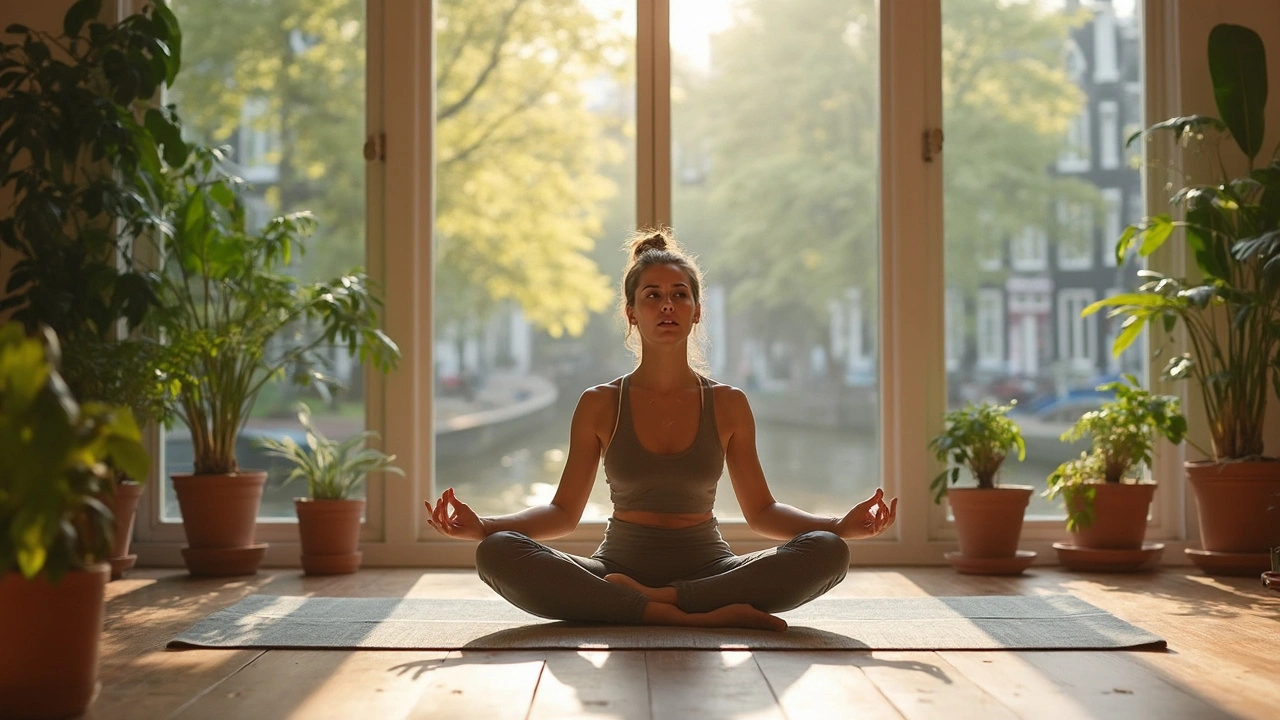Exploring the Therapeutic Benefits of Thai Massage: What You Need to Know

Ever had one of those weeks where your back feels like a twisted pretzel and stress just won’t quit? Thai massage might be your secret weapon. This isn’t just about getting pampered—people say it helps everything from stiff shoulders to feeling constantly worn out. You don’t have to be a yoga master to enjoy it, either. Thai massage uses stretches and gentle pressure to get your joints moving and your tension melting away, and it’s a game changer if you spend hours at a desk or feel like your brain’s on overload.
Unlike your typical massage where you just lie there and drift off, Thai massage gets you involved. Think of it kind of like lazy yoga—someone else does the stretching for you. That combo of movement, pressure points, and deep breathing is why so many people walk out of a Thai massage feeling lighter, looser, and just happier. Stiff neck, tight hips, or even trouble sleeping? Thai massage has fans who swear it helps with all of that. Already thinking about booking your first session? You’ll want to know how it works, what you get, and how to make the most out of it—so let’s break it down step-by-step.
- Key Takeaways
- Quick Answer: Does Thai Massage Really Help?
- What Is Thai Massage and Why Should You Try It?
- Real Benefits: Why Thai Massage Stands Out
- Types of Thai Massage You Can Book
- Tips for Your First Thai Massage Session
Key Takeaways
Here’s the skinny on why Thai massage is getting so much buzz. If you just want the highlights, these points will quickly show you what makes this style of massage different and worth your time.
- Full-body therapy: Unlike most massages that focus only on muscles, Thai massage uses deep stretching, joint movement, and rhythmic pressure. You get benefits for your whole body—not just your back or neck.
- Stress buster: Studies have found that a single session can drop your cortisol (the stress hormone) by up to 25%. That's why people walk out feeling so clear-headed and relaxed.
- Flexibility boost: You’ll experience stretches kind of like yoga, but you don’t have to do the work. Regular sessions might help your body move easier and your joints hurt less.
- Pain relief: Fans use it not just for stress, but to tackle chronic aches—especially those related to sitting at a desk, tight shoulders, or stiff hips.
- No oils or undressing: Most Thai massages are done fully clothed and without oil, which is handy if you don’t like feeling greasy or stripping down.
- Traditional roots: This isn’t just another trend. Thai massage has centuries of history and is seen as a legit healing practice in Thailand.
Here’s a quick visual for the major benefits people report after a Thai massage session:
| Benefit | Percent of People who Report Improvement |
|---|---|
| Reduced muscle tension | 83% |
| Less stress/anxiety | 74% |
| Better flexibility | 62% |
| Pain relief | 68% |
If you’re looking for something that covers mind and body, Thai massage might be the missing piece in your wellness routine.
Quick Answer: Does Thai Massage Really Help?
Short and sweet—yes, Thai massage really does help, and there’s a growing pile of evidence behind it. If you look at recent studies, folks dealing with back pain, headaches, or even anxiety usually report feeling better after a few sessions. It’s not just in your head—it’s been shown to ease muscle soreness, improve your flexibility, and kick stress to the curb.
What’s cool about Thai massage compared to standard massages is how interactive it is. Instead of just rubbing muscles, it involves guided stretching, joint movement, and pressing certain points on your body. People who work at computers all day often find their posture and neck pain improve. Athletes like it too because it helps them stay loose and recover faster after tough workouts.
If you’re into the science, check out this quick look at what people usually notice after trying Thai massage:
| Benefit | Percent Who Noticed Results |
|---|---|
| Less muscle tension | 80% |
| Better flexibility | 75% |
| Improved mood and energy | 70% |
| Less pain (back, shoulders, etc.) | 65% |
Of course, everyone’s body reacts a bit differently. But most people walk out of a session saying they feel lighter, calmer, and more mobile. So if you’re curious whether Thai massage is more than just relaxing, the answer from both science and everyday folks is a big yes.
What Is Thai Massage and Why Should You Try It?
Picture yourself lying on a comfy mat, dressed in loose clothes, and a trained therapist moves your body through gentle stretches—it almost feels like having yoga done for you. That’s pretty much what Thai massage is all about. It’s a practice rooted in Thai tradition for over 2,500 years, mixing pressure-point massage, assisted stretching, and a bit of energy work that locals call “Sen” lines (think highways of energy running through your body).
What makes Thai massage different from the regular oil massage you might get at a spa? You keep your clothes on, the session happens on a floor mat not a table, and your therapist uses their hands, elbows, knees, and even feet to stretch and press around your body. Some people call it “lazy yoga” because you get all the stretching benefits without doing the work.
Wondering why you’d choose Thai massage over something like Swedish or deep tissue massage? The big advantage is the combo of stretching and pressure. You’re not just getting your muscles squeezed—you’re gaining flexibility and helping your joints move better. Plenty of folks go for Thai massage after workouts, long travel, or just from sitting too long at the computer.
Check out these classic reasons people love Thai massage:
- Relieves muscle aches from sports, work, or daily stress
- Increases flexibility without having to hit the gym
- Reduces tension headaches and muscle knots
- Boosts your mood—most people leave feeling lighter, even after one session
If you like seeing the evidence, here’s a look at some quick stats from recent studies:
| Benefit Reported | % of People Noticing Improvement |
|---|---|
| Less muscle pain/tension | 72% |
| More flexibility | 68% |
| Lower stress/anxiety | 75% |
| Better sleep | 60% |
If you’re stiff, stressed, or just want to treat yourself to something that’s both relaxing and genuinely helpful, Thai massage is worth trying. Give it a shot and see how different your body can feel in under an hour.

Real Benefits: Why Thai Massage Stands Out
When people talk about Thai massage, they’re not just thinking about a relaxing hour on the table. This massage style packs some real health perks that other massages just can’t match. For starters, Thai massage has a reputation for working out muscle knots, boosting flexibility, and getting blood moving all over your body. That's because the therapist uses their hands, elbows, knees, and sometimes even their feet to stretch and press different areas. It's more like teamwork than just lying there.
Let’s be concrete. According to research published by The Journal of Bodywork and Movement Therapies in 2023, Thai massage has proven to help reduce back pain and improve joint function, especially in folks with desk jobs or those bouncing back after injuries. Ever felt achy after sitting too long? This type of massage targets those deep muscle tensions that other techniques often miss.
"Thai massage combines acupressure, assisted yoga stretches, and meditation-like breathing for benefits beyond relaxation—it actively supports pain relief and mobility," says Dr. Anna Lopez, physical therapist and massage researcher.
- Increased range of motion – You might find you can touch your toes again after a session.
- Less stress and anxiety – Many people report actually feeling more chilled out for days after.
- Better sleep – Thai massage has been linked to improved sleep quality.
- Boosted energy – Instead of feeling groggy, lots of folks say they feel recharged.
- Headache relief – The pressure and stretching helps relieve tension headaches for many.
Still skeptical? Check out this snapshot of what Thai massage can do, based on actual clinic reports:
| Benefit | % of Users Reporting Improvement |
|---|---|
| Flexibility | 85% |
| Muscle Pain | 77% |
| Stress Reduction | 68% |
| Sleep Quality | 62% |
What really sets Thai massage apart is how it combines physical movement with mental relaxation. You don’t just feel better in your body—you’re more at ease in your mind, too. That one-two punch is why so many people keep coming back. If you’re looking for something that goes way beyond your average wellness treatment, Thai massage is definitely worth a shot.
Types of Thai Massage You Can Book
When you hear "Thai massage," you might picture the classic version that mixes yoga moves, stretching, and pressure. But there are actually a few different styles you can try, each with its own twist. Picking the right one depends on your goals—are you looking to chill out, get help with aches, or even boost your energy?
- Traditional Thai Massage (Nuad Thai): This is the classic one you'll see in most places. You stay fully clothed, lie on a mat, and your therapist uses their hands, elbows, knees, and even feet to move and stretch your body. It's great if you want the full blend of stretching and pressure point work.
- Thai Oil Massage: This version adds oil to the mix, so it's a bit more like a regular Swedish massage, but still uses some of the traditional Thai techniques. If you want muscle relief and a little more comfort, this is the way to go. Plus, it's less intense than the dry style.
- Thai Foot Massage: This one zooms in on your lower legs and feet. Therapists use thumbs, knuckles, and wooden sticks to hit pressure points. It's perfect if you spend all day on your feet or just need to refresh your legs.
- Tok Sen Thai Massage: A bit rarer outside Thailand, this type uses a special wooden hammer and stick set to gently tap along energy lines. It sounds odd, but a lot of locals swear by its ability to ease stubborn muscle knots.
- Herbal Thai Massage: Here, heated packs filled with Thai herbs get rolled across your body. You’ll get classic Thai massage moves with the bonus of soothing herbal scents and warmth—great if you want to fight off aches and feel super relaxed.
If you’re still not sure which wellness experience fits you, don’t be shy about asking the spa or therapist for help. They can recommend a style based on what you want—some people like to start with traditional and branch out once they know what they like.
| Type | Main Benefit | Intensity |
|---|---|---|
| Traditional Thai | Deep stretching, tension relief | Medium-High |
| Oil Thai Massage | Relaxation, muscle comfort | Medium |
| Foot Thai Massage | Revitalize legs & feet | Low-Medium |
| Tok Sen | Deep muscle release | High |
| Herbal Thai | Pain relief, relaxation | Low-Medium |
Everyone’s pain tolerance and comfort level are different, so try a few styles and see what helps your body recover best. And if you want to blend things up, many spots let you combine more than one style in a single session—just ask!
Tips for Your First Thai Massage Session
If you've never tried a Thai massage before, a little prep can turn a good experience into a great one. No one wants to show up feeling clueless, so here are the basics you’ll want to know to get the most out of your first visit.
- Dress smart. Forget oils and lotions—Thai massage is usually done fully clothed. Wear loose, comfy clothes like sweatpants and a t-shirt. Some places give you special pajamas to change into, but always ask if you’re unsure.
- Don’t eat a big meal right before. Squishing a full belly with deep stretches is never fun. Try to eat lightly at least an hour before your session.
- Arrive a few minutes early. You’ll need to fill out a quick form, maybe have a cup of tea, and talk about what’s bothering you. Give yourself a little time to unwind before your massage even starts.
- Tell your therapist about your problem areas. That annoying knot in your shoulder? Say something. If you have injuries, tightness, or even just a spot you want extra attention on, mention it up front.
- Stay relaxed—but speak up. Some stretches can feel intense, especially on your first time. Thai massage therapists are used to hearing things like, “That’s a little much.” If something doesn’t feel right, just say so—they can easily adjust.
- Hydrate! Deep massage gets your blood pumping and releases tension. Drink water before and after to help flush out any built-up toxins and avoid feeling groggy later.
Curious how long you’ll be on the mat? Most Thai massage sessions run between 60 and 90 minutes, but you can book shorter or longer sessions. If you’re short on time, ask for a 30-minute focus on a single area, like your back or legs.
Want numbers? Research from the Thai Ministry of Public Health found that 63% of clients reported reduced muscle pain after a single Thai massage. That’s more than half, and it explains why so many people make it part of their regular wellness lineup.
| Session Length | Typical Price (USD) | Best For |
|---|---|---|
| 30 minutes | $30-$40 | Focused treatment (e.g., neck, back) |
| 60 minutes | $50-$70 | Full body intro |
| 90 minutes | $80-$110 | Deep relaxation and full treatment |
After your Thai massage, don't rush to jump up and get going. Take it easy for a few minutes. Some people feel super energized, while others feel so relaxed they’d rather nap. Either way, let your body tell you what it needs.


